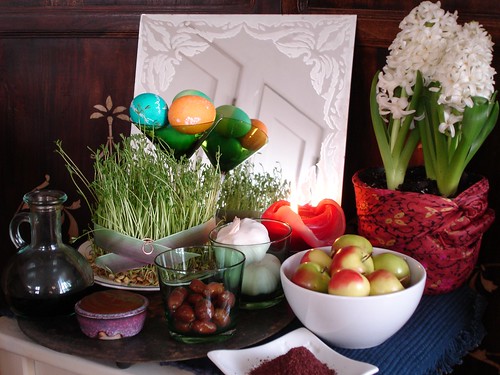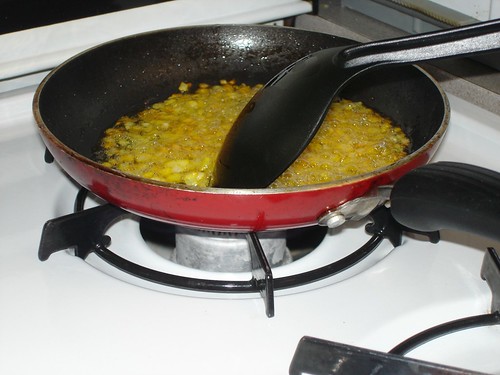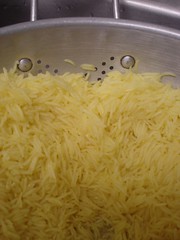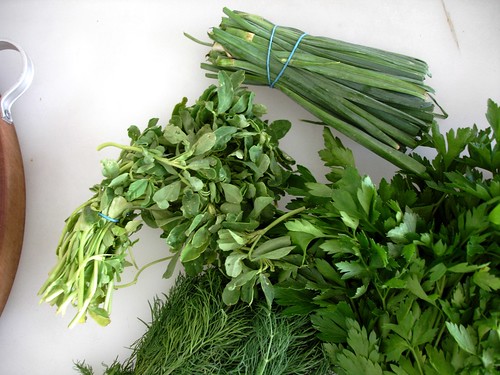 UPDATE: Here are a couple pictures of the finished product from my mom's dining table.
UPDATE: Here are a couple pictures of the finished product from my mom's dining table.Persian New Year (call it what you will: norouz, nowruz, Persian Park Day, whatever) looms once again. Which is to say, spring has sprung. The traditional meal of this lovely day is sabzi polo mahi -- rice with four herbs, served with fish. The green flavors of the herbs blend with the light perfume of basmati rice for an aromatic and seriously comforting dish. And its cheery green colors are perfect to ring in the season.
This is the first Persian rice recipe I'm posting here, but I don't want to get bogged down in the details of Persian rice in general (believe me, there are many -- I could go on and on). Let me just mention the very basics: the goal of Persian rice dishes, in stark contrast to east Asian sticky rice dishes, is an end result with distinct long grains of Basmati rice. You want to remove as much starch as possible, and handle the rice carefully to avoid breaking individual grains. To that end, the rice is soaked in salt water for a few hours, then parboiled, then steamed for an hour, in a pot with a small amout of oil and water at the bottom. The end result has a magic not unlike that of Jello 1-2-3: a mound of perfectly cooked rice, and hiding beneath it, the coveted tahdig, a layer of browned rice, crispy and delicious (and when I say coveted, I mean coveted by your older brother. Eat it up fast before he snatches it from your plate!).
I offer my mother's sabzi polo recipe below. There are a lot of steps here, and a lot of prep work. Keep in mind that this is part of a cuisine that has been perfected over the years by women who cooked for their families every single night. So, yeah, it's a little complex. Having said that, Violet's recipe is meticulously detailed, and offers myriad troubleshooting tips. And furthermore, unless you're cooking for your Iranian mother-in-law, no one will notice the minutiae, and they'll still be amazed with the flavors.
Oh, and for more information and photos from this beautiful holiday, here is a post from last norouz.
Violet's Sabzi Polo
The rice:
2 cups basmati rice
2 tbs salt
1/4 tsp turmeric (optional)
2-3 tsp oil (vegetable or canola are the conventional choices, but I use olive oil)
The herbs below combined, should add up to at least 2 cups. Use less of pungent fenugreek than the other three. You can use a food processor to chop all of them, except the chives, which will turn to paste. Feel free to process the stems in with the leaves.
Persian chives (tareh), or the green part of green onions
flat-leaf parsley
dill
fenugreek (shambalileh)
The piaz dagh (saffron caramelized onions):
1/2 onion, chopped finely
3-4 tbs oil
pinch ground saffron
1-5 Hours Ahead
Wash rice three times: Place rice in a small bowl. Cover with water, about one inch higher than the surface of the rice. Stir by clawing through with fingers. Drain carefully – use hand to block rice grains from washing away with water, and take care to prevent rice from toppling over and spilling out of the bowl as you drain it. Repeat this process 2 more times.
Cover rice with water, 1 ‘finger’ (about 1/2 inch) higher than its surface. Add salt; stir to combine. Let sit 1 - 5 hours. More than this, and the salt will harden the rice too much.
Prepare piaz dagh
 Combine all ingredients in a medium saucepan. Cook over high heat, stirring frequently until it has a beautiful golden color (to quote Violet, "golden is tasty, brown is bitter"), about 8 minutes. Savor the smell of your kitchen.
Combine all ingredients in a medium saucepan. Cook over high heat, stirring frequently until it has a beautiful golden color (to quote Violet, "golden is tasty, brown is bitter"), about 8 minutes. Savor the smell of your kitchen.Parboil
 After soaking has completed, do the initial boil of rice: Bring 5 cups of water to a boil, covered, in a medium non-stick pot over high heat. Carefully add rice, with its water. Gently stir through with a spatula, making sure to scrape up the grains at the bottom of the pan. Watch pot until it comes back to the boil. For polo, add turmeric now, and stir to combine – this will give it an even pale yellow color. Lower to medium. Leave on heat for 3-10 minutes.
After soaking has completed, do the initial boil of rice: Bring 5 cups of water to a boil, covered, in a medium non-stick pot over high heat. Carefully add rice, with its water. Gently stir through with a spatula, making sure to scrape up the grains at the bottom of the pan. Watch pot until it comes back to the boil. For polo, add turmeric now, and stir to combine – this will give it an even pale yellow color. Lower to medium. Leave on heat for 3-10 minutes.How do you know when parboil is done? To test when the rice is ready to be drained, put one grain under the tooth. It should not be hard in the middle – not raw, but not soft/cooked either. Individual grains should look elongated. It's best not to overcook the rice at this stage. If it's undercooked, you can make up for it in the steaming stage. But if it's overdone, there's no help for mushy rice.
Remove from heat and drain into a large colander. Rinse and dry pot.
Assemble and Steam
Add oil and 2-3 tsp water to above pot (Note: if you are not immediately cooking rice, only add about half of the water, then pour the rest over top immediately before cooking, to prevent rice from getting mushy). Shake pot to incorporate water and oil.
Into the colander of rice, add about 1/3 of herbs. Season salt and pepper. Within the colander, gently mix about 1/3 of rice into herbs. Use a fork, not a spatula, and take care to break as few grains as possible. With a wide spatula, pour herbed rice into pot, in an even layer. Drizzle with 1/3 of piaz dagh, including oil.
Repeat this process twice. As you add subsequent layers, shape rice in pot into the form of a mountain: as little of the rice as possible should touch the sides of the pot, because it will burn in a dry, unsavory form.
Using the handle of a fork, make about 5 'chutes' from top to bottom of mound of rice: one in the center, and 4 around the periphery. Poke the fork handle through the rice to the bottom of the pot, then move it gently and slightly from side to side to open the chute to about 1 inch diameter.
Place pot over medium-high heat, covered. When it’s ready (see below), lower the heat to low, and allow to cook for 1 hour. (You can cook it at very low heat for longer, to create a thicker tah-dig – just beware that if it burns, it’s very sad.)
Check rice after the first 20 or so minutes, and troubleshoot:
- Too dry? Add oil.
- Too hard? Add water.
- Not enough salt? Add more.
- Too smushy? Place a cloth rag or towel tautly over the pot, then cover. Fold the ends over the lid, so that they are not near the fire. This will absorb any steam that develops and prevent it from re-incorporating into the rice.
To make sure it’s hot enough to lower heat:
- check for much steam on the underside of the lid of the pot
- listen for sizzling and sputtering
- as mamanini did: wet your finger and stick it on the side of the pot – if it sizzles, it’s ready.
To serve, use a large spatula or thin saucer to scoop rice into serving platter. Either break tahdig into chunks and serve atop rice, or carefully invert entire tahdig into a large round platter.


Where's the after photo? Your yellow rice looks awesome. Well done!
ReplyDeleteHooray for Persian Park Day! You should totally write a cookbook....
ReplyDeleteah, caught! tsp, we were too hungry to take pictures before we ate it all up!
ReplyDeleteWow! Thank you for all the step by step detail.
ReplyDeleteKheily motshakarram!
ReplyDelete